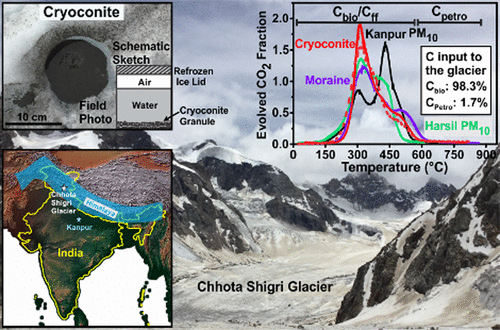当前位置:
X-MOL 学术
›
Environ. Sci. Technol.
›
论文详情
Our official English website, www.x-mol.net, welcomes your feedback! (Note: you will need to create a separate account there.)
Biomass-Derived Provenance Dominates Glacial Surface Organic Carbon in the Western Himalaya.
Environmental Science & Technology ( IF 11.4 ) Pub Date : 2020-06-25 , DOI: 10.1021/acs.est.0c02710 Sarwar Nizam 1 , Indra S Sen 1 , Velu Vinoj 2 , Valier Galy 3 , David Selby 4, 5 , Mohammad F Azam 6 , Satyendra K Pandey 2 , Robert A Creaser 7 , Avinash K Agarwal 8 , Akhilendra P Singh 8 , Michael Bizimis 9
Environmental Science & Technology ( IF 11.4 ) Pub Date : 2020-06-25 , DOI: 10.1021/acs.est.0c02710 Sarwar Nizam 1 , Indra S Sen 1 , Velu Vinoj 2 , Valier Galy 3 , David Selby 4, 5 , Mohammad F Azam 6 , Satyendra K Pandey 2 , Robert A Creaser 7 , Avinash K Agarwal 8 , Akhilendra P Singh 8 , Michael Bizimis 9
Affiliation

|
The origin, transport pathway, and spatial variability of total organic carbon (OC) in the western Himalayan glaciers are poorly understood compared to those of black carbon (BC) and dust, but it is critically important to evaluate the climatic role of OC in the region. By applying the distribution of OC activation energy; 14C activity; and radiogenic isotopes of 208Pb/204Pb, 207Pb/204Pb, and 206Pb/204Pb in glacial debris and atmospheric particulate matter (PM10 size fraction), we demonstrate that 98.3 ± 1.6 and 1.7 ± 1.6% of OC in western Himalayan glaciers are derived from biomass and petrogenic sources, respectively. The δ13C and N/C composition indicates that the biomass is a complex mixture of C3 vegetation and autochthonous photoautotrophic input modified by heterotrophic microbial activity. The data set reveals that the studied western Himalayan glacier has negligible contributions from fossil-fuel-derived particles, which contrasts to the central and eastern Himalayan glaciers that have significant contributions from fossil fuel sources. We show that this spatial variability of OC sources relates to regional differences in air mass transport pathways and precipitation regimes over the Himalaya. Moreover, our observation suggests that biomass-derived carbon could be the only primary driver of carbon-induced glacier melting in the western Himalaya.
中文翻译:

在喜马拉雅山西部,生物质衍生的来源占冰川表面有机碳的主导地位。
与黑碳(BC)和粉尘相比,喜马拉雅西部冰川中总有机碳(OC)的起源,运输途径和空间变异性知之甚少,但是评估OC在该地区的气候作用至关重要。地区。通过分配OC活化能的分布;14 C活动;以及冰屑和大气颗粒物(PM 10尺寸分数)中208 Pb / 204 Pb,207 Pb / 204 Pb和206 Pb / 204 Pb的放射同位素,我们证明了98.3±1.6和1.7±1.6%的OC喜马拉雅山西部冰川分别来自生物质和成岩来源。δ13 C和N / C组成表明生物量是C3植被和通过异养微生物活性改性的自生光自养输入的复杂混合物。数据集显示,所研究的西部喜马拉雅冰川的化石燃料来源颗粒贡献可忽略不计,这与喜马拉雅中部和东部冰川的化石燃料来源贡献显着。我们表明,OC来源的这种空间变异性与喜马拉雅地区的气团传输路径和降水机制的区域差异有关。此外,我们的观察结果表明,喜马拉雅西部地区生物质衍生的碳可能是碳诱导的冰川融化的唯一主要驱动力。
更新日期:2020-07-21
中文翻译:

在喜马拉雅山西部,生物质衍生的来源占冰川表面有机碳的主导地位。
与黑碳(BC)和粉尘相比,喜马拉雅西部冰川中总有机碳(OC)的起源,运输途径和空间变异性知之甚少,但是评估OC在该地区的气候作用至关重要。地区。通过分配OC活化能的分布;14 C活动;以及冰屑和大气颗粒物(PM 10尺寸分数)中208 Pb / 204 Pb,207 Pb / 204 Pb和206 Pb / 204 Pb的放射同位素,我们证明了98.3±1.6和1.7±1.6%的OC喜马拉雅山西部冰川分别来自生物质和成岩来源。δ13 C和N / C组成表明生物量是C3植被和通过异养微生物活性改性的自生光自养输入的复杂混合物。数据集显示,所研究的西部喜马拉雅冰川的化石燃料来源颗粒贡献可忽略不计,这与喜马拉雅中部和东部冰川的化石燃料来源贡献显着。我们表明,OC来源的这种空间变异性与喜马拉雅地区的气团传输路径和降水机制的区域差异有关。此外,我们的观察结果表明,喜马拉雅西部地区生物质衍生的碳可能是碳诱导的冰川融化的唯一主要驱动力。


























 京公网安备 11010802027423号
京公网安备 11010802027423号